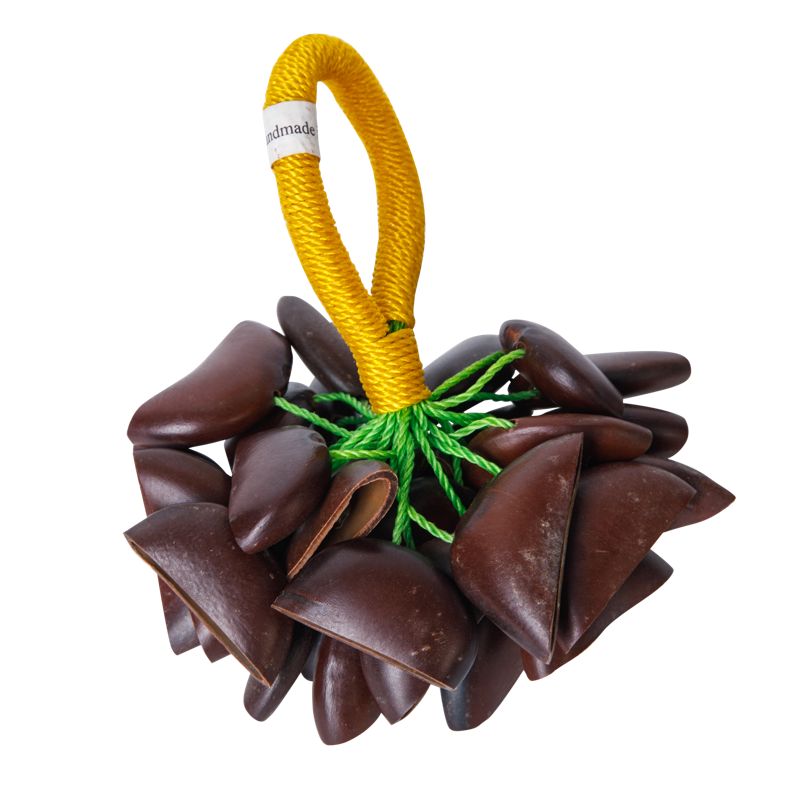chuanling overview
 String bells (pinyin: Chuànlíng), which are several small bells in the shape of a horseshoe (or semicircle, rod, etc.) strung with metal, which are pronounced through vibrations caused by tapping, shaking or shaking. The timbre is crisp, the volume is low, the sound is scattered, and it can continue to play long notes. When performing, it is especially necessary to master the timing of rhythm insertion, which is generally used on the upbeat or upbeat of the music.
String bells (pinyin: Chuànlíng), which are several small bells in the shape of a horseshoe (or semicircle, rod, etc.) strung with metal, which are pronounced through vibrations caused by tapping, shaking or shaking. The timbre is crisp, the volume is low, the sound is scattered, and it can continue to play long notes. When performing, it is especially necessary to master the timing of rhythm insertion, which is generally used on the upbeat or upbeat of the music.The bells were originally ornaments and ringers tied to the necks of domestic animals such as mules, horses, donkeys, and dogs. It is made by hanging more than twenty metal bells on a cloth belt or belt. The small bell is cold-pressed or cast into two hemispheres with copper and iron, and then the spherical body is synthesized. Sizes vary from 2 cm to 6 cm in diameter. One side of the outer side of the bell is provided with a ring ear for hanging, and the other side has a slender opening for the sound outlet, and an iron bead is installed inside the bell. In addition to the spherical shape, the small bells have various shapes such as oval, gourd, and peach. In addition to the one-line opening, the sound holes are also arc-shaped and herringbone-shaped.
Indian folk musical instruments, formerly known as Jinkini, are recorded in the Lotus Sutra. It is a kind of metal hollow ball with a gap on the side and a small bead inside. A single small bell is strung into a chain, that is, a string of bells, which is pronounced when shaken. It was originally a traditional ornament for Indian women. It was tied to the hands and feet when dancing, stomping the feet and clapping the palms to make rhythmic sounds. This object is borrowed from Buddhism. In the frescoes of the early Northern Wei and Western Wei Dynasties in the Mogao Grottoes, bells were often decorated on the necks of Bodhisattvas and Tiangong musicians. After the Sui and Tang Dynasties, the Bodhisattva's clothing and accessories gradually became Sinicized, and the string bells gradually disappeared. There are also occasional traces of bells in some tassel patterns on the drapery.
- Pinyin:Chuànlíng
- Classification:body music
- how to play:tapping, shaking, or shaking
reference materials and contributors
- 串铃 · 百度百科
- 串铃乐器的演奏方法 · 艺考网
- 串铃历史与特色简介 民族乐器串铃图片及演奏方法介绍 · 乐器资料
overview of other similar instruments
- sanyanxiao overview
- Daguangxian overview
- Leiqin overview
- hahao overview
- yandundagu overview
- Han Xiaozheng overview
- Fang Xiang overview
- guanzi overview
- zhuqin (Dao Qin) overview
- zhuiqin overview
- bangzi overview
- three-stringed piano overview
- Gehu overview
- xiao overview
- xiaokonghou overview
- Konghou overview
- Sheng overview
- suona overview
- hulusi overview
- gushao overview
 渝公网安备 50010702504639号
渝公网安备 50010702504639号